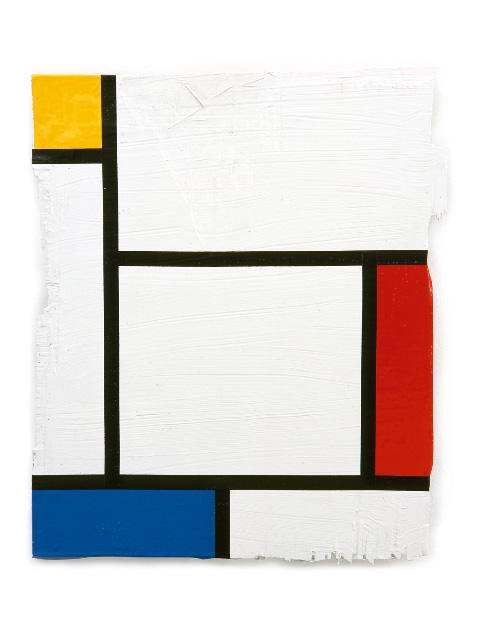Antithèse de la copie

Copie, sosie, pastiche/comme pour mieux troubler les sens, l’exposition Seconde Main s’est installée au cœur des collections du musée d’Art moderne de la Ville de Paris et brave sans complexe une dominance historique, bien que désormais rétrograde, de l’œuvre originale.
Présentant une sélection de pièces conçues entre 1960 et aujourd’hui, elle est une occasion volontairement confondante de confronter une notion survivante dans l’histoire de l’art à une réalité de production qui s’est depuis longtemps détachée des codes de la représentation unique. On sait que Duchamp et les ready-made autant que Warhol ont été des acteurs déterminants dans cette tentative à scinder l’original de l’authentique. On comprend par la visite de Seconde Main, que cette question fondamentale s’est saisi de tous les médiums et qu’elle laisse transparaître autant une réflexion de l’art dans son rapport à l’économie qu’une pensée de nature philosophique.
Rosalind Krauss a écrit au sujet de la copie qu’elle représente un défi en ce qu’elle ne promeut ni l’unicité de l’une ou de l’autre mais que, par la multiplication, elle a fait faire éclater cette même notion d’unicité. La copie a su disloquer l’opposition binaire qui la relie à l’original et à son éternel aura pour investir les notions
de simulacre et de répétition qui lui confère sa singularité.
Les tableaux de Mondrian ici représentés par les œuvres de Sherrie Levine, General Idea, Mathieu Mercier et Tom Sachs s’inscrivent dans une approche académique de la peinture, du temps ou les élèves copiaient leurs maîtres afin d’acquérir leurs compétences. Mais par ce geste, et bien que leurs intentions soient différentes, elles refont surgir une forme de « non-sens » à reproduire Mondrian, copiés tant de fois par des artistes sans qualité, « non-sens » dans lequel elles trouvent justement leur origine et leur dimension critique.
Dans le contexte de Seconde Main, l’installation de Malevitch occupe une position particulière en ce qu’elle est un point de jonction entre les deux expositions imbriquées.
The Last Futur exhibition reconstitue une exposition montrée par le suprématiste russe vers 1915 et réalisée à partir de l’unique cliché pris dans son contexte d’origine. L’ensemble est peint de façon volontairement grossière et n’a d’identique que le nom de l’auteur. Comme pour Mondrian, seule la date, voir le titre, indique de façon claire que nous sommes face à une copie (en 1985, Malevitch n’était plus) et le visiteur de croire à une œuvre originale de la collection du Musée.
La transformation et la réinterprétation de l’œuvre qu’engendre la copie suscite une déconstruction de l’histoire ; dans ce rapport, la copie s’enrichit d’une multitude de sens et laisse transparaître en retour que « l’original lui-même n’est rien d’autre qu’une copie universalisée » (1).
(1) Marina Grzinic, Une fiction reconstruite, Paris, L’Harmattan, 2005, p. 96.
Seconde Main
Musée d’art moderne de la ville de Paris
25 mars – 24 octobre 2010.
Antithesis of the Copy
By Estelle Nabeyrat
Copy, lookalike, pastiche/as if to better confuse senses and meanings, the exhibition Seconde Main has been set up at the heart of the collections of the Musée d‘art moderne, and straightforwardly challenges an historical, albeit now reactionary, dominance of the original work.
In presenting a selection of pieces devised between 1960 and today, it offers a deliberately muddling opportunity to confront a notion surviving in art history with a reality of production that has long since been separate from codes of one-off representation. We know that Duchamp and the readymades as much as Warhol were decisive figures in this attempt to split the original and the authentic. We understand from a visit to Seconde Main that this basic question has involved all media and that it puts across as much a reflection on art in its relation to the economy as a philosophical line of thinking.
RosalindKrauss wrote about the copy that it represents a challenge insomuch as it promotes neither the uniqueness of one or other, but that, by multiplication, it has exploded this very motion of uniqueness. The copy has managed to dismantle the binary contrast that links it to the original and to its everlasting aura, to inform the notions of simulacrum and repetition which lend it its singularity.
Mondrian’s pictures here represented by the works of Sherrie Levine, General Idea, Mathieu Mercier and Tom Sachs are part and parcel of an academic approach to painting, and to the time when pupils copied their masters in order to acquire their skills. But through this gesture, and even if their intentions may be different, they bring back out a form of “non-sense” in reproducing Mondrian, copied so many times by two-bit artists, “non-sense” in which, as it happens,they find their origin and their critical dimension.
In the context of Seconde Main, Malevich’s installation occupies a special position insomuch as it is a point of junction between the two dovetailed shows.
“The Last Future Exhibition” re-creates an exhibition shown by the Russian Suprematist in about 1915 and made on the basis of the single photo taken in its original context. The whole is painted in an intentionally coarse way and has neither identity nor author’s name. As for Mondrian, only the date,and the title, clearly indicate that we are looking at a copy (in 1985, Malevich was no longer among us) and it is up to the visitor to believe in an original work from the museum collection.
The transformation and re-interpretation of the work engendered by the copy bestirs a deconstruction of its history; in this relation, the copy is enhanced by a whole host of meanings and shows, in return, that “the original itself is nothing other than a universalized copy1.”
1 A reconstructed fiction, Marina Grzinic, Paris, L’Harmattan, 2005, p.96.
- Partage : ,
- Du même auteur : Noam Toran au Lieu du Design, Paris, Su-Mei Tse à la La Fondation Prince Pierre,
articles liés
Leonor Serrano Rivas
par Mya Finbow
Flux de nos yeux
par Gabriela Anco
Electric Op
par Sandra Doublet


